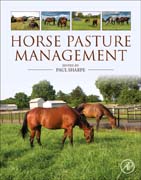
Horse Pasture Management begins with coverage of the structure, function and nutritional value of plants, instructing those working in and studying equine management how to identify pasture grasses and legumes, as well as weeds and toxic plants. Management of the soil and plants in a pasture is covered next, followed by horse grazing behavior, feed choices of horses, management of grazing horses and calculation of how many horses should be grazing relative to the land available. A section on turf management is included for those interested in equestrian sports who may need to design, create and maintain a course for events or races. Also featured is a section on how to make and preserve hay and silage. The section on weather, climate and plant hardiness is useful for those working in less familiar regions where they may not have knowledge of which types of forage plants thrive. Environmental protection related to agriculture and manure management are also covered, as well as the risks involved with and solutions for too much water, too little drainage and too much traffic in a limited area. The number of metabolic problems from which horses may suffer depending on how they are managed on pasture is also featured, as well as interaction with the wildlife in and surrounding a horse farm, with techniques for wildlife encouragement and control. Contributions are rounded out with a chapter explaining the economic benefits of improvements in pasture management. Provides the basic principles of pasture management for those involved in equine-related fields and studyCovers a variety of strategies for managing the behavior, grouping, environment, and feeding needs of the animals to ensure horse welfare and healthIncludes information on environmental best practices, plant and soil assessment, and wildlife concernsHighlights case studies of successful existing extension programs INDICE: 1. Forage plant structure, function, nutrition and growth 2. Nutritional value of pasture plants for horses 3. Identification of forage plant species 4. Soil types, structure, properties that affect pastures, nutrients, acidity, fertility and management and evaluate potential for forage growth 5. Pasture establishment methods 6. Pasture plant management and renovation 7. Forage yield and its determination 8. Weed identification 9. Managing Weeds 10. Toxic Plants and other hazards 11. Grazing behavior, feed intake and feed choices 12. Grazing Management and Stocking Rates 13. Calculating stocking rates, stocking intensities and numbers of rotational grazing paddocks 14. Multi-species grazing (cattle, goats, sheep) 15. Turf management for equestrian sports 16. Hay and silage production and management 17. Climate, Weather and Plant Hardiness 18. Matching plant species to your environment, weather and climate 19. Manure Management 20. Environmental Protection with Streamside Grazing Method 21. Renovating Wet Areas in Pastures and Yards 22. Fencing and watering systems 23. Avoiding Metabolic Problem 24. Managing Drought and Flood Conditions 25. Co-existing With Wildlife 26. The University of Kentucky Extension Pasture Evaluation Program 27. The University of Maryland Equine Rotational Grazing Site 28. Economic benefits of improvements in pasture management
- ISBN: 978-0-12-812919-7
- Editorial: Academic Press
- Encuadernacion: Rústica
- Páginas: 516
- Fecha Publicación: 01/11/2018
- Nº Volúmenes: 1
- Idioma: Inglés
